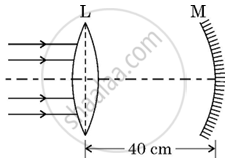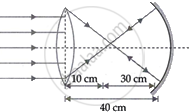Advertisements
Advertisements
प्रश्न
| A lens is a transparent optical medium bounded by two surfaces; at least one of which should be spherical. Applying the formula of image formation by a single spherical surface successively at the two surfaces of a thin lens, a formula known as lens maker’s formula and hence the basic lens formula can be obtained. The focal length (or power) of a lens depends on the radii of its surfaces and the refractive index of its material with respect to the surrounding medium. The refractive index of a material depends on the wavelength of light used. Combination of lenses helps us to obtain diverging or converging lenses of desired power and magnification. |
A thin convex lens L of focal length 10 cm and a concave mirror M of focal length 15 cm are placed coaxially 40 cm apart as shown in figure. A beam of light coming parallel to the principal axis is incident on the lens. The final image will be formed at a distance of ______.

पर्याय
10 cm, left of lens
10 cm, right of lens
20 cm, left of lens
20 cm, right of lens
उत्तर
A thin convex lens L of focal length 10 cm and a concave mirror M of focal length 15 cm are placed coaxially 40 cm apart as shown in figure. A beam of light coming parallel to the principal axis is incident on the lens. The final image will be formed at a distance of 10 cm, right of lens.
Explanation:

The image of the lens will be formed at point 'R' which is the centre of curvature of the mirror.
